More symbols
Here are some more musical symbols, which are used to notate more detailed variations of written music.
Lines
The final barline indicates the end of the piece.
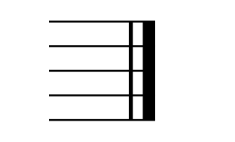
The repeat sign indicates that a section of the music should be repeated (think brackets).
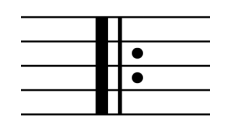
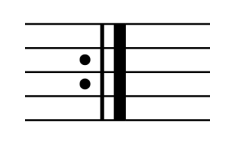
If there is only the second repeat sign, start over from the beginning and play everything again. If two repeat signs enclose a section of the music (with the two dots pointing inwards), repeat this section only. After the repetition you move on or stop if it is the end of the piece.
Repetitions can also have different endings. In this case the different endings are indicated by so called voltas. Play the first volta when reaching it, then repeat the section and play the second volta (skipping the first volta). There can be more than two voltas as well.

The pedal sign tells you to use the sustain pedal.
![]()
8va tells you to play the notes indicated an octave above.
 8vb tells you to play the notes indicated an octave below.
8vb tells you to play the notes indicated an octave below.
![]()
Tempo
The tempo of a piece is usually written above the first line of music. It consists of a note value and a number. The number indicates the tempo in beats per minute (bpm). It tells you to which speed you should set your metronome to play the piece. The note symbol tells you the note value for each beat of the metronome. For example:
 This tempo mark tells you to set the metronome to 80 bpm and use every beat as a quarter note value.
This tempo mark tells you to set the metronome to 80 bpm and use every beat as a quarter note value.
![]()
This tempo mark tells you to set the metronome to 60 bpm and use every beat as a half note value.
In classical music, tempo is notated in words, oftentimes in Italian language. Common tempo descriptions are largo (broadly, 40–60 bpm), lento (slowly, 45–60 bpm), andante (walking pace, 76–108 bpm), moderato (moderate speed, 108–120 bpm), allegretto (moderately fast, 112–120 bpm), allegro (fast, quickly, 120–156 bpm), presto (very fast, 168–200 bpm).
Dynamics
There are several symbols to depict changes in loudness, also called dynamics, in the music. The letters p and f are derived from the italian with piano meaning quiet or soft and forte meaning loud. Very soft (pianissimo) is written as pp, very loud (fortissimo) as ff. Mp means medium soft (mezzo piano) and mf means medium loud (mezzo forte).
Here are the letters in order from very soft to very loud:
![]()
Changes in volume can be depicted by hairpins. It gets quieter in the direction of the closed end, or louder in the direction of the open end.

The same change in volume can be marked by the italian words crescendo (increasing), decrescendo (decreasing) or diminuendo (diminishing).
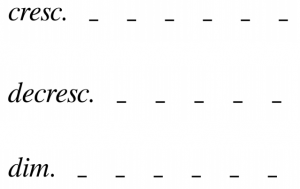
Articulation
There are also symbols to tell you how specific notes are supposed to be played or articulated.

An accent signifies that the marked note should be emphasized by a stronger attack.
![]()
A dot above or below the note means staccato (Italian for detached). The marked note should be played with a very short
attack.
![]()
A horizontal line above or below the note means tenuto (Italian for held). It tells you to hold the note for its full length or play it
slightly louder.
![]()
The opposite of staccato is legato (Italian for connected), where the notes that are connected by a slur are to be played connected as
if flowing into one another.

A grace note is a very short attack on another note, before the proper target note is played. It is a very common feature in blues, funk, gospel or jazz.
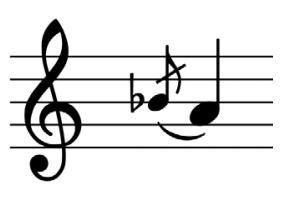
Grace notes are notated as a tiny note before (or after) the target note. When counting, you count only the target note, with the grace note happening within the note value of the target note. On the piano grace notes can be played by either sliding off (black keys) to the target note with the same finger or by playing two separate attacks with different fingers.
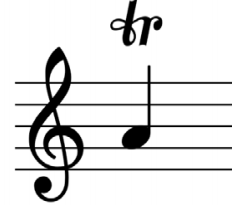
A trill tells you to play a fast alternation of the written note and the next note above (within the scale) for the duration of the written note. For the example on the left, it would be a fast alternation between A and B for the duration of a quarter note.

